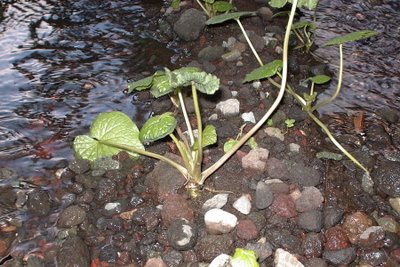 So apparently what I've been eating for years is not what I thought it was....
So apparently what I've been eating for years is not what I thought it was...."Wasabi (wah-sah-bee), often incorrectly called Japanese horseradish, is among the most misunderstood yet integral aspect of the sushi experience. What looks like a lump of green putty is a very complex, spicy yet sweet compliment to your sushi meal. This sushi (and noodle) accompaniment provides a bounty of flavor, spiciness, and a dash of color to your dish while enhancing the subtle flavor of the fish.
So what is wasabi? Wasabi is a plant grown primarily in Japan with nascent horticulture now in the Pacific northwest of the US. The root (technically a rhizome) is ground and used in foods to add spiciness and flavor. It is a difficult plant to grow, requiring a rocky stream or riverbed and the proper mix of nutrients, and is therefore a somewhat rare commodity. Wasabi, traditionally reserved for sushi and noodles, is now being incorporated into a plethora of foods; however, 'wasabi' flavored items are not always actually wasabi flavored.
When dining and served wasabi with your sushi, the wasabi you are served is not always what it seems. Due to a high demand and limited supply, what is often served with your sushi is a mix of American horseradish, mustard and coloring, which the Japanese call seiyō wasabi (“western wasabi”). This is because real wasabi can be hard to find or very expensive outside Japan (up to $100/lb). Wasabi is also sometimes powdered and reconstituted with water, and while this is sometimes served as well, the volatile compounds that make wasabi so unique are lost when the rhizome is powdered, so what you end up is an inferior product (which too is often mixed with American horseradish).
If you would like to be sure what you have, you can ask your wait staff if what you are served is 'real wasabi' or 'fresh wasabi' and if not, if it is available. If you are served putty, more than likely it is not real. Real wasabi is grated (traditionally on a sharkskin grater called an oroshi) and looks as such. Fake wasabi is not and does not. Just ask your wait staff for 'fresh wasabi' and if they have the real thing, they will usually return with a dish with a grated pile of the real thing, which is a very different experience from fake wasabi.
If you are buying wasabi in store, read the label to determine if you have real wasabi or something else.Real wasabi has a fruity and vegetal fragrance, with a spiciness that does not linger and serves to enhance the flavor of the fish. It has a bouquet and sweetness that stimulates the palate with balanced heat. It does not hit with the intensity that fake wasabi does, and the spiciness quickly dissipates into the sweet vegetal flavor that is a perfect companion to sushi. The hotness of wasabi is experienced more in the sinus than the tongue and is often an acquired taste.
Wasabi has shown in studies to be anti-microbial and possibly anti-carcinogenic, the former may be why it has long been eaten with raw fish, which in the past was not handled with the care it is today. It is also suggested that it may have anti-inflammatory and blood thinning properties, both useful to the medical community. It is even used in toothpaste in Japan for its anti-bacterial properties!
As you can plainly see, wasabi is a unique plant and more intriguing food. While a mystery to many, this sushi side item is actually very important to many sushi connoisseurs. If you have the opportunity to try the real thing you should be pleasantly surprised. This rare commodity is a spicy treat that is finally being given the praise it deserves as it spreads throughout the food community."



0 Comments:
Post a Comment
<< Home